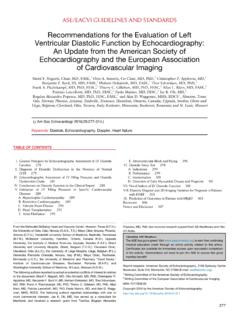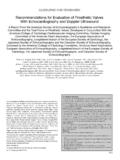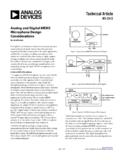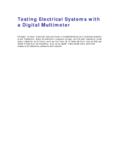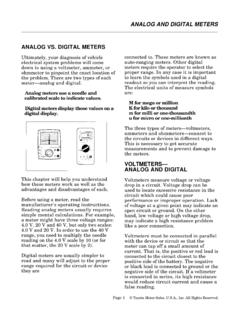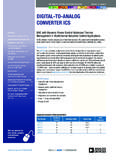Transcription of Guidelines and Recommendations for Digital …
1 AMERICAN SOCIETY OF echocardiography REPORTG uidelines and Recommendations for DigitalEchocardiographyA Report from the Digital EchocardiographyCommittee of the American Society ofEchocardiographyWriting Committee: James D. Thomas, MD (Chair), David B. Adams, RDCS,Stephen DeVries, MD, Donna Ehler, RDCS, Neil Greenberg, PhD, Mario Garcia, MD,Leonard Ginzton, MD, John Gorcsan, III, MD, Alan S. Katz, MD, Andrew Keller, MD,Bijoy Khandheria, MD, Kit B. Powers, MD, Cindy Roszel, RDCS, David S. Rubenson, MD,and Jeffrey Soble, MDEXECUTIVE SUMMARYD igital storage and review is now the state of theart in echocardiography , and practitioners areurged to move quickly to an all- Digital solution intheir laboratories.
2 Although secondary digitizationfrom videotape may be an acceptable transitionalsolution, the ultimate benefits of the Digital labo-ratory can only be achieved with direct digitaloutput from a contemporary echocardiographymachine. Standardization of storage format is crit-ical to enable interoperability within and betweenlaboratories; adherence to the DICOM (DigitalImaging and Communications in Medicine) stan-dard should be ensured in all applications. Toachieve studies of acceptably small size, one mustuse both clinical compression (ie, storage of 1 orseveral cardiac cycles from selected views) anddigital compression (more efficient storage ofindividual frames and loops). Lossless compres-sion (Packbits run-length encoding) is used byDICOM and is useful for storing still frames suchas spectral Doppler or M-mode.
3 Motion-JPEG is theonly lossy compression approved by the DICOM committee, and compression ratios as high as 20:1are supported by the literature and used by man-ufacturers (see Section for an explanation ofPackbits and lossless/lossy terminology). Moreaggressive compression schemes (eg, MPEG-1,MPEG-2, and wavelets) are under evaluation byDICOM but for now remain nonstandard for DI-COM exchange, although they may be useful forreal-time transmission and review over digitalnetworks and the Internet. Hardware require-ments for the Digital laboratory include high-speednetworking (100 megabits per second [Mbps]being the minimum speed in even a medium-sizedechocardiography laboratory), industry-standardservers, and storage schemes that support bothrapid access for recent and returning patients(RAID [redundant array of inexpensive hard disks]hard-disk array with several weeks to months ofstorage) and long-term archiving on Digital tape,DVD, or magneto-optical media for at least 7 Digital solutions (hardware, network-ing, and software) are available from several ven-dors, or one may prefer to integrate these 3components individually.
4 During the transitionperiod, parallel review of Digital clips and video-tape is quite helpful, but in the long run, it isrecommended that videotape be used only as abackup in case of network failure and to allowsecondary digitization of transient events that maynot have been captured digitally. Unless the vid-eotapes are fully reviewed and their content in-cluded in the diagnostic interpretation, it is rec-ommended that videotape not be archived but berecycled, perhaps in 1 week s time. A number ofpitfalls are discussed, including noisy ECG signals,which can lead to capture of truncated cardiaccycles, and atrial fibrillation, which requiresmultibeat capture. It is emphasized that digitalechocardiography is an evolving field, with futureintegration anticipated with hospital registrationand results-reporting standards.
5 Nevertheless, thefield has reached such a state of maturity andstability that an unequivocal recommendation canbe made for all- Digital capture, storage, and reviewReprint of these documents, beyond single use, is prohibitedwithout the prior written authorization of the reprint requests to the American Society of Echocardiog-raphy, 1500 Sunday Drive, Suite 102, Raleigh, NC 27607, phone:(919) Am Soc Echocardiogr 2005;18 $ 2005 by the American Society of any contemporary echocardiography to the many nuances discussed in theentire document, our overall Recommendations in-clude the following: Digital capture, storage, and review are recom-mended for all echocardiography laboratories, re-gardless of DICOM format should be used for storage anddata careful clinical editing and Digital compres-sion (within DICOM) are required to keep study ( 100 Mbps) networking and aswitched architecture are needed for large short- and long-term storage is neces-sary, ideally with full mirroring videotape recording is useful for short-term redundancy and to ease the Digital transforma-tion.
6 Once transformation is complete, videotapeshould not be archived in the long with computerized reporting softwareis strongly years of development, standardization, andrelatively slow implementation, the echocardiogra-phy world should now fully embrace all- Digital stor-age and analysis. For those laboratories that havemade the transition, the advantages of Digital echo-cardiography are all too obvious, with improvedefficiency, quality, and clinical service provided totheir referring physicians. However, despite thefeasibility and advantage of Digital echocardiogra-phy,1-4a recent review of the Laboratory DataProject of the American Society of Echocardiogra-phy revealed that only a small minority of echocar-diography laboratories currently consider them-selves predominately Digital in their data those laboratories still waiting to convert, wehope that this document will provide both theinformation and the impetus to move them into theall- Digital document represents the official publicationfrom the Digital echocardiography Committee ofthe American Society of echocardiography .
7 Thecommittee began meeting in 2001 and has mettriannually since then to identify the issues, pitfalls,and potential solutions for those who seek to adopta Digital echocardiography laboratory. This reportwill outline some of the historical and technicalbackground of Digital echocardiography , addressimplementation issues for both physicians andsonographers, and introduce concepts beyond meredigital-image storage, such as structured reportingand integration with hospital of Digital EchocardiographyDigital echocardiography offers many advantagesover analog tape storage:1) More efficient reading, because the echocardi-ographer can direct his or her attention tospecific clips and review data easily to puttogether a coherent interpretation of the ) More convenient reading, because the studiesare stored on a central server and are availableto be pulled up on any computer served by thatdepartment s network or, via virtual privatenetworks, anywhere in the ) Easy comparison with previous studies, whicheliminates the need to rummage through racksof old videotapes and search for a )
8 Easier quantification, because spatial, tempo-ral, and velocity calibration is built directly intothe image, and quantification tools can gener-ally be accessed instantaneously within thereviewing ) More convenient communication with the re-ferring physician, whether by the inclusion ofimages within a report or by virtue of beingable to pull up studies instantly to review thepertinent findings of the ) Higher image quality, because the images ap-pear exactly as they were originally recordedfrom the machine, without any degradationfrom the videotaping ) More stable image quality, because over time,videotape degrades continuously, whereas dig-ital files remain intact (as long as the mediumon which they are stored is preserved).
9 8) Integration of the images and reports withinthe hospital s electronic medical ) More robust research, because the highest-quality images are available for quantitativemeasurement with built-in calibration. Digitalfiles may also be forwarded instantaneouslyfrom acquisition site to a core laboratory, per-mitting both better quality assurance and moretimely ) Easy implementation of a clinical quality-assur-ance program, whereby echocardiograms canbe re-reviewed randomly on a regular ) Improved accuracy and reproducibility ) Greater facilitation of medical education, be-cause moving images can now routinely beincluded in computer-projected presentationsat local, national, and international have been relativelyfew formal studies to examine the cost-effectivenessof Digital echocardiography .
10 One recent study eval-uated the accuracy, concordance, and cost-effective-ness of Digital versus analog echocardiography for101 patients with valvular heart ,Journal of the American Society of Echocardiography288 Thomas et alMarch 2005the 2 methodologies gave highly concordant results,but the Digital review took 38% less time thanvideotape review, whereas Digital storage (an aver-age of 60 megabytes [MB] on a CD-ROM) costs 31 vs 62 for Super VHS videotape [NB: contemporarystorage on Digital tape would cost less than 5 perstudy, further magnifying the cost advantage ofdigital echocardiography ]. A similar study in pediat-ric echocardiography showed a cost disadvantagefor Digital storage but used very expensive magneto-optical disks as the argumentscan be made for Digital echocardiography on thebasis of a decrease in cost, by far the most compel-ling argument is on the basis of increased quality DevelopmentA full description of the history of Digital echocardi-ography is found in Appendix A, with the readerreferred to prior references for further ,8 This Appendix may be found ISSUESI ntroduction to the TerminologyThe hallmark of Digital storage of video data is therepresentation of the image at discrete points on thescreen (pixels)


